Enjoying Ancient Buildings, Folk Culture in Liping

Liping, a county in Qiandongnan Miao and Dong Autonomous Prefecture, in southwest China's Guizhou Province, has a history that dates back more than 1,300 years. More than 70 percent of residents in Liping County are ethnic Dong people. Liping is also known for its picturesque landscapes, well-preserved Dong culture, and "red tourism" resources.
Liping is situated in southeastern Guizhou Province, where Guizhou borders central China's Hunan Province and south China's Guangxi Zhuang Autonomous Region. Given its geographic position, Liping was an economic and cultural center, and a transportation hub in southeastern Guizhou, during ancient times.

Zhaoxing Dong Village, situated in southeastern Liping County, is one of China's largest and oldest villages inhabited by ethnic Dong people. Construction of the village began during the Southern Song Dynasty (1127-1279). The dwellings, culture and folk customs of the ethnic Dong people are well-preserved in Zhaoxing. The village is the ideal spot to sample and savor authentic Dong culture. In 2005, Zhaoxing was ranked as one of China's six most beautiful villages by Chinese National Geography.
Zhaoxing is nestled in a basin surrounded by green mountains. A small river flows through Zhaoxing. Terraced steps, constructed by locals, creep up along the slopes. Dong people live in wooden-stilted buildings (diaojiaolou) on the hillside. The buildings are constructed with wooden pillars, to protect locals from being attacked by snakes and wild beasts. The wooden cottages usually have two or three floors. The locals live on the top floor, while their animals and firewood are kept on the ground floor.
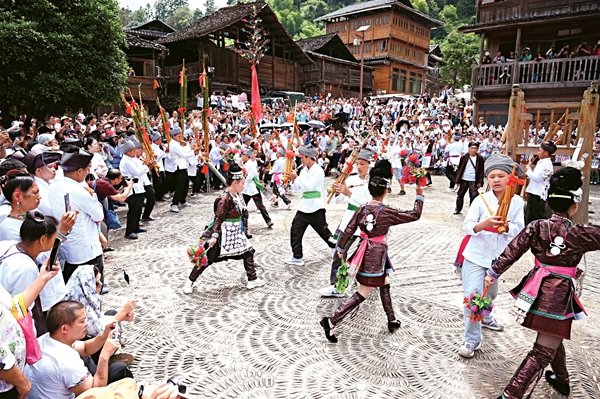
According to lore, Dong people have three treasures — drum tower, wind and rain bridge, and the Dong chorus. The drum tower is the symbol of a Dong village, and it is often the tallest building in the village. The drum tower represents luck and prosperity. To the surprise of most, Dong people do not use nails or rivets to construct a drum tower. Instead, the wood beams are fitted together with wooden joints.
In the past, if an emergency occurred, the Dong people would climb to the top of the drum tower, and they would beat the drum to warn the village. The drum tower is also where the Dong people would hold meetings and grand events, including weddings and funerals, welcoming guests, and worshiping their ancestors. During festivals, they gather in the square, in front of the tower, to sing and dance.
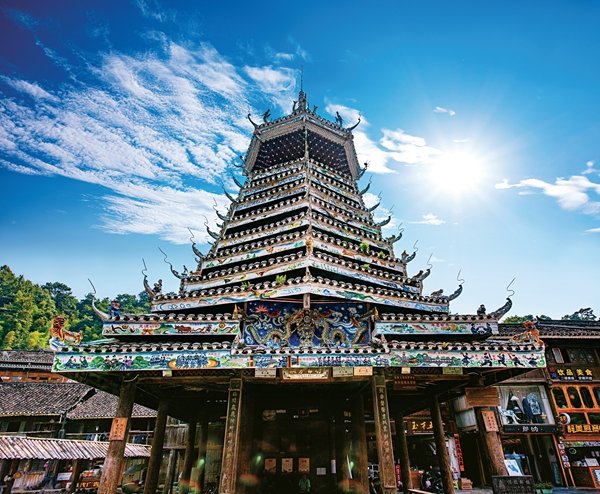
Dubbed "the hometown of drum towers," Zhaoxing is renowned for its five drum towers, each of which has a history of several hundred years. The towers are named: Ren, Yi, Li, Zhi and Xin, which refer to the good virtues of benevolence, righteousness, courtesy, wisdom and trust in Chinese tradition. The towers' interiors and exteriors are painted with murals of landscapes, animals, legendary heroes and the Dong people's folk tales.
Dong villages are typically situated on the banks of rivers or streams, so bridges are essential to Dong people. The wind and rain bridge, also called flower bridge, was built especially by the Dong people. The bridge combines a tower and a pavilion, and it is decorated with exquisite sculptures and frescoes. Zhaoxing has five wind and rain bridges. The Dong people do not use nails or rivets to construct the bridges. The bridges are still sturdy, despite having been built hundreds of years ago. The bridges not only provide shelter to people from the wind and rain, they are where locals welcome or say goodbye to friends and relatives.
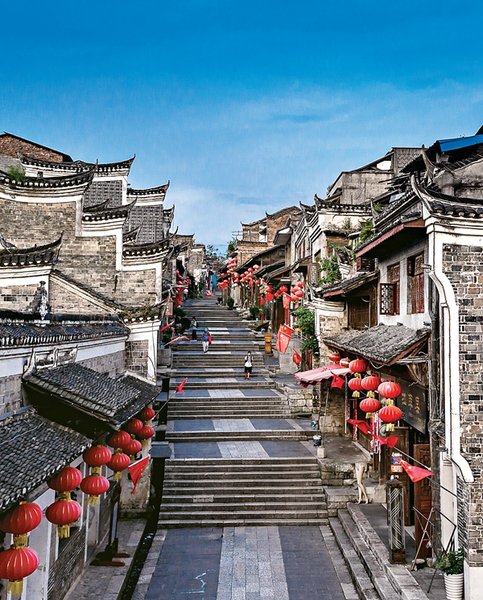
Zhaoxing is a gem, boasting many notable historic and folk-cultural treasures. The unique buildings of the Dong ethnic group combine to form a magnet that draws visitors and shutterbugs to the village.
Defeng Ancient Town, which has a history of more than 600 years, is situated in Liping. The ancient town's traditional layout and construction style have distinct features. Qiaojie Street, which extends nearly 1,000 meters, was the town's cultural and commerce center. Qiaojie Street (qiao means "being raised or elevated" in Chinese) got its name from its unique architectural style. Both sides of the street are elevated, but the middle is flat, given its geographical location between two mountain slopes.
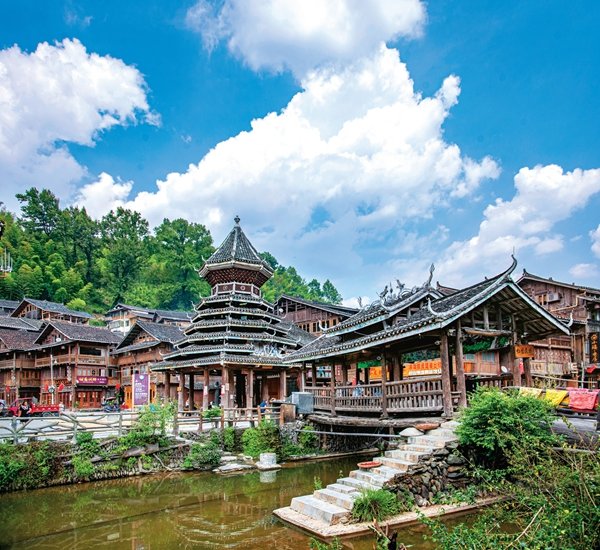
The street boasts well-preserved ancient buildings, which date back to the Ming (1368-1644) and Qing (1616-1911) dynasties. While walking along the street, visitors may feel like they have traveled back in time.
Liping also has "red-tourism" attractions. In December 1934, the Red Army arrived in Liping. The Political Bureau of the Central Committee of the Communist Party of China held the famous Liping Conference in a house on Qiaojie Street. The Memorial to the Liping Conference, which displays many pictures and objects from the conference and the Red Army's Long March, is a national patriotic education base.
Photos from VCG and Tuchong
(Women of China English Monthly August 2024)
Editor: Wang Shasha
Please understand that womenofchina.cn,a non-profit, information-communication website, cannot reach every writer before using articles and images. For copyright issues, please contact us by emailing: website@womenofchina.cn. The articles published and opinions expressed on this website represent the opinions of writers and are not necessarily shared by womenofchina.cn.


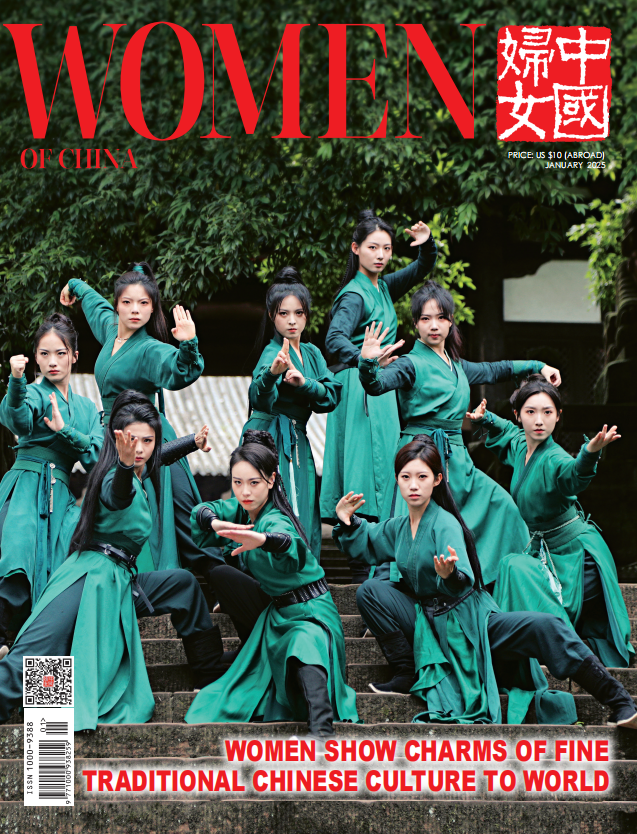

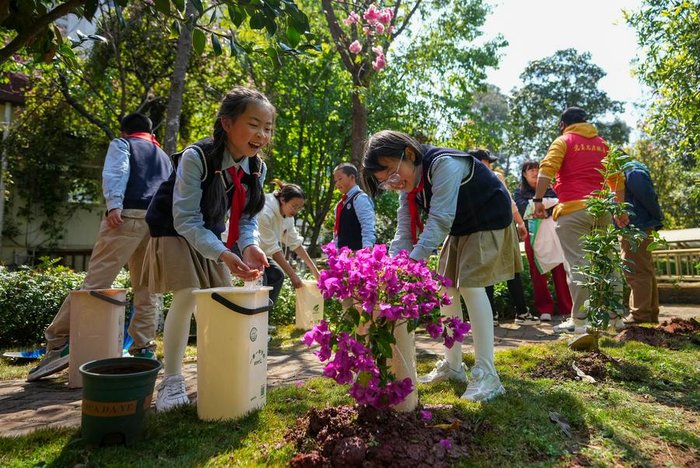

.jpg)

 WeChat
WeChat Weibo
Weibo 京公网安备 11010102004314号
京公网安备 11010102004314号